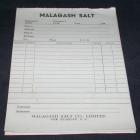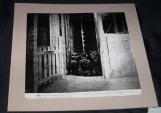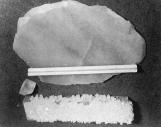34
This booklet which was produced by the Department of Mines and is dated 1920, describes the salt deposit located at Malagash, Nova Scotia.36
One of the order forms for the various types of salt produced by the Malagash Salt Company.38
An extract from the interview with Kenny Wilson, who began work at the Malagash Salt Mine in 1950.So what kind of markets were there back then for the salt?
Mostly Newfoundland, fish salt, hay salt in the summertime. We couldn't sell enough of the fine salt that we got; they had to dump it over the bank actually.
The fine salt you mean, like the table salt?
It turned out like table salt because of the explosion of the dynamite - we didn't sell table salt, it was just industrial, you know hay salt and fish salt.
So the fish salt that was for salting the cod and so on?
That's right, Newfoundland.
So what was the hay salt exactly?
When you put hay in the barn, you ever hear tell of hay catching on fire by itself?
Yes.
If you put salt, a layer of hay and a little bit of salt on it, it prevents it from heating and it also helps the protein in the hay stay green.
40
100 foot stope in Chemical Vein (MacKay Seam) circa 1924, Malagash Salt Mine.42
Miners descending down the shaft in the Malagash Salt Mine in early 1940's.44
THE USES OF MALAGASH SALTThe salt was sold as a hay and fish preservative throughout the Maritimes and Newfoundland. Its colour, a brownish white, militated against it for that purpose, and it had the peculiar quality of adhering to fish. In the late 1920's, highway engineers were seeking a cheap means of prolonging the surface of dirt roads which were beginning to suffer the ravages of heavy motor traffic. The problem was solved by the ingenuity of A. R. Chambers. He found that rock salt mixed with clay presented a tough surface, and Malagash Salt appeared on the verge of prosperity. Each year more and more salt was sold for highway use, as a dust layer and for a primitive type of hard surfacing. Car-load lots were shipped to central Canada and as far west as Prince Albert, Saskatchewan. The meat packers in Winnipeg, Burnes and Swift, became customers. The C.N.R. took Malagash salt for their refrigerator cars. The Nova Scotia Highways Minister Hon. Percy C. Black, in whose constituency the Malagash Mine was located, favoured its use, and as the 1930's began the company's prospects were favourable.
As the thirties waned and the forties came, war or no war the public wanted to drive its better cars the whole year round, winter and summer.
Snow plows kept the roads free of snow. Salt spread thinly from the backs of trucks on the roads, was the answer to ice. It was found cleaner and more efficient than sand. A fairly coarse grade was produced for highway ice-control - which worked on the well-known fact that salt lowered the freezing point of water, thus converted dangerous ice to soft slush.
Thus did the Malagash Salt Company come into its own. De-icing winter highways saved the day. In early autumn 1948, J. L. Cavanaugh journeyed to Toronto and sold 3,000 tons of rock salt to the government of Ontario, to de-ice highways. By spring of 1949 that initial order had grown to 7,000 tons per year.
From 1949 on its sales of salt, in bags and bulk, steadily increased. The City of Montreal and the Highways Department of the Province of Ontario were added to the company's list of customers, and the Maritime Provinces network of paved roads found Malagash rock salt a winter necessity.
LAND SALT
The sale of land salt reached considerable proportions in the early 1920's. There are farmers who declare that the salt not only sweetened the soil but also actively promoted growth.
46
Kenny Wilson, who began work at the Malagash Salt Mine in 1950 speaks about some of the problems the mine was encountering during the mid 1950's.So basically it was like a lot of places today, you know they lay off and hire on again, was it seasonal for a fair bit of the time, or would you become full time there after you had been there after a few years?
It became full time after? er?they hired me on the core drill to go around Nova Scotia looking for salt, because the seam here of salt we had to follow it; and after so many years of mining it had become very costly to bring the salt to surface. They had to have different hoists and everything underground. We couldn't take any big equipment underground, the seams were so crooked, drifts went in different directions, down hill and up hill. And after a while, about 1954, it cost pretty near as much to get the salt up as you could get for it. That and the railroad prices were going up all the time.




